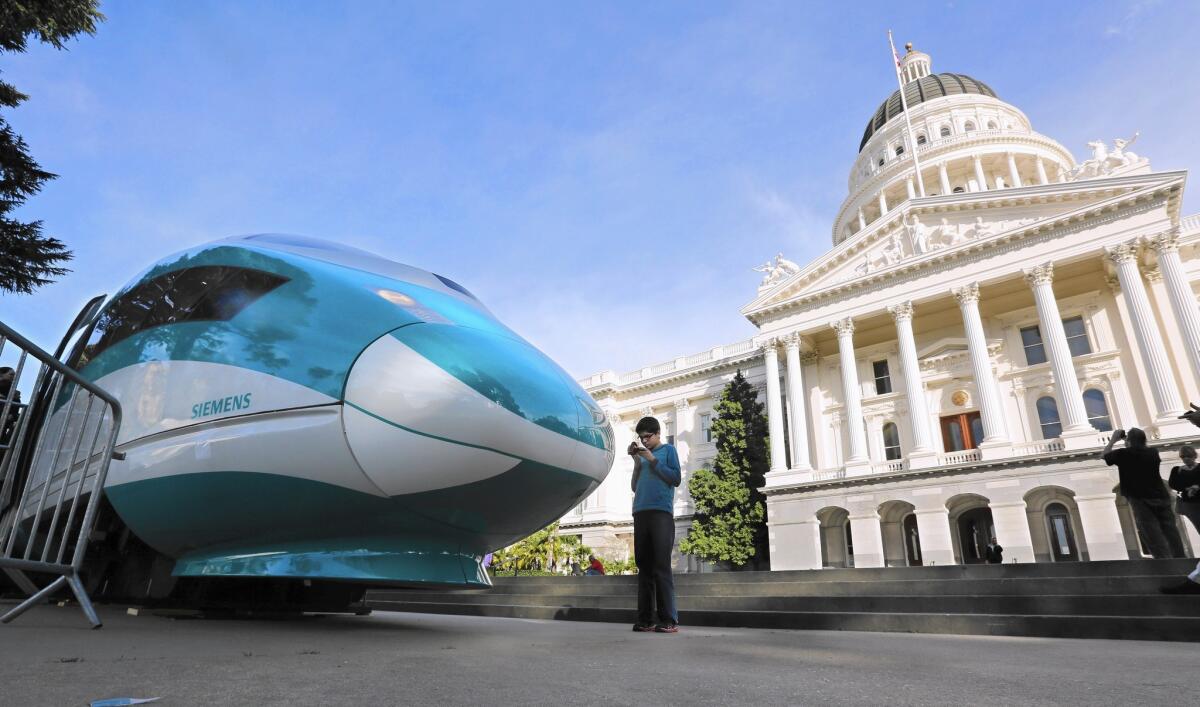Bullet train planners eye a northerly starting point

A full-scale mock-up of a high-speed train is displayed at the state Capitol in Sacramento last fall. Project officials now plan to build the rail system’s first leg from San Jose to Bakersfield rather than in Southern California.
While state officials plan to make a “significant investment” and continue planning for the section of the California bullet train system that would end in Southern California, they are now proposing to build and open a northern section first.
The California High Speed Rail Authority’s initial operating segment had been expected to end in Burbank before eventually reaching Anaheim, but officials said in a telephone conference Thursday that a new draft business plan, which the authority is required to produce every two years, proposes to start with a Bakersfield to San Jose segment instead.
NEWSLETTER: Stay up to date with what’s going on in the 818 >>
Dan Richard, chairman of the authority board, and Jeff Morales, the authority’s chief executive, both said the reason for flipping the switch to the northerly section was financial.
“It’s just longer and more expensive to get to L.A.,” Richard said. “Looking at the available funds, we just couldn’t. We couldn’t get there.”
The Central Valley to Silicon Valley segment can be built, opened and operated with foreseeable funds, they said, and would better comply with 2008’s Proposition 1A bond program.
That means it would operate at the required speed and could be operated without a subsidy, they said, and it’s expected to be operating by 2025. Completion of the system from San Francisco to the Los Angeles Basin is still expected by 2029.
The plan also proposes seeking $2.9 billion in federal funds for work to reach from San Francisco, which they said would generate an additional $4.7 billion in operational revenue for the system.
Officials also plan to have “dollars flowing” for an investment in the Burbank-to-Anaheim segment this year, part of a $2-billion expansion of the rail system’s scope in the busy corridor where Metrolink, Amtrak and freight trains operate.
That work, expected to involve grade-separation work necessary to incorporate high-speed rail, made possible after estimates of the total project’s costs were revised down from roughly $68 billion to $62 billion, based on experiences the authority has gained during the past two years. With the expanded scope, the new total estimate is roughly $64 billion, Richard said.
As evidence of the continued commitment to Southern California, Morales pointed to the authority’s approval this week of a resolution to provide up to $15 million in funding for a project to integrate high-speed rail at Los Angeles Union Station.
The southerly segment, particularly from Palmdale to Burbank, for which several routes have been proposed, would involve engineering and environmental challenges, such as possible tunneling under the Angeles National Forest.
Residents in northern parts of Los Angeles County have aggressively criticized the proposed routes from Palmdale to Burbank as likely to endanger or destroy communities or natural resources along their paths.
Environmental studies and engineering work for those proposed routes will continue under the new business plan, Richard said, so that, should funding for additional work become available, the authority will be poised to begin construction as soon as possible.
Morales said the new plan, which officials stressed is in draft form and will be open to public comment and hearings over the next 60 days, reflects what would be the “prudent thing.”
“This is all about doing everything we can with the available funding and then positioning ourselves to get the rest of the system delivered,” he said.
--
Chad Garland, chad.garland@latimes.com
Twitter: @chadgarland
